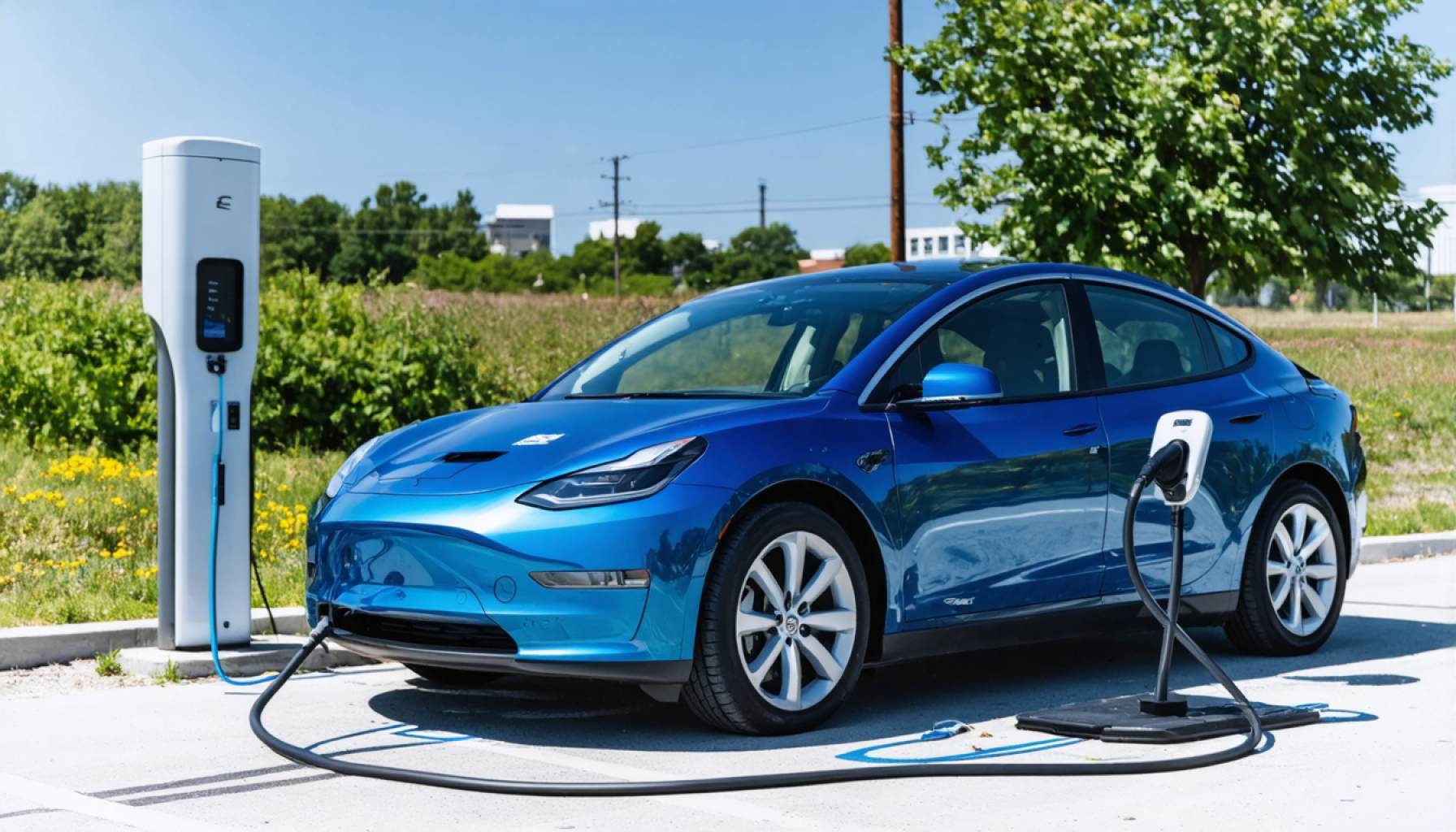
- Miami Valley is advancing sustainability by installing 24 new electric vehicle (EV) chargers.
- The project is funded by $1.1 million from federal Carbon Reduction program funds, managed by the Miami Valley Regional Planning Commission.
- The EV chargers are placed on public lands across various locations like Centerville, Bellbrook, and Brookfield.
- Currently, 18 chargers are operational, with the rest expected to be active within six months.
- Brian Martin, the Executive Director, emphasizes the project’s focus on improving air quality and reducing emissions.
- Library and park locations provide convenient spaces for EV drivers to recharge while contributing to environmental goals.
- Advocates believe the availability of robust infrastructure is key to encouraging wider adoption of electric vehicles.
- The initiative signifies a significant step towards a future with accessible and sustainable EV infrastructure in Miami Valley.
The Miami Valley is taking a definitive step into the future, sparked by the installation of 24 new electric vehicle (EV) chargers breathing life into a collective vision for a greener community. The hum of electricity and the subtle click of an EV plug into a freshly minted charger at the Trotwood branch of the Dayton Metro Library marked this electric dawn—a ceremony that intertwined technology with nature.
At the financial heart of this endeavor is the Miami Valley Regional Planning Commission, which, with its crystal-clear focus on sustainability and improved air quality, has orchestrated this forward-thinking initiative. Infusing $1.1 million from federal Carbon Reduction program funds, the commission is lighting the path for an environmental renaissance, underwriting the chargers’ design, construction, and operating costs for the next five years.
These chargers are more than just metal and circuitry. Placed strategically on public lands—from the bustling corridors of Centerville to the serene byways of Bellbrook and Brookfield—they beckon EV drivers to park, explore, and plug in. Of the 24 chargers, 18 are already buzzing with activity, while the remaining will come to life over the next six months, their presence easily traced through EV charging network apps like Blink and ChargePoint.
For Brian Martin, the commission’s Executive Director, the project isn’t simply about infrastructure. It revolves around safeguarding the region’s current air quality, which shines like a beacon among the nation’s environmental concerns. The passive power of a parked EV, minimizing the cacophony of tailpipe emissions, represents a quiet revolution in city planning—one that Martin passionately champions.
Data has long established the shadowy link between carbon emissions and air quality, which drove the commission to solicit site recommendations from various member communities starting in fall 2022. Libraries, parks, city halls, and county edifices emerged as the prime venues—places bustling with life and activity, where an hour spent recharging an EV extends the gift of extra mileage.
For advocates such as Rap Hankins from Drive Electric Dayton, the new chargers aren’t just a convenience; they’re a cornerstone of empowerment. Hankins has long recognized that robust infrastructure is the undisputed vote of confidence consumers need to embrace electric mobility. With each new charger, Miami Valley moves closer to a future where “EVs for all” is not just an aspiration, but a lived reality.
Let the electric dawn rise over the Miami Valley, bridging technology and tradition, and casting a lasting legacy of sustainability for generations to come. As the stainless steel chargers gleam under the Midwestern sun, they signal more than just progress—they herald a hopeful horizon.
Revolutionizing Green Mobility: Miami Valley’s Electric Vehicle Charging Expansion
Unpacking the Revolution: Electric Vehicles in Miami Valley
The Miami Valley’s leap towards sustainable transportation is firmly rooted in the installation of 24 new electric vehicle (EV) chargers. This initiative, championed by the Miami Valley Regional Planning Commission, is powered by a $1.1 million grant from the federal Carbon Reduction program. While the source article introduces this transformative step, let’s delve deeper into the multifaceted implications of this project for the community and beyond.
Why Electric Vehicle Charging Matters
The strategic placement of these chargers aims to boost both environmental and user convenience:
– Environmental Impact: EVs contribute to improved air quality by reducing harmful tailpipe emissions. By offering accessible charging options, Miami Valley not only promotes cleaner air but also establishes itself as a leader in green living.
– User Empowerment: The infrastructure promotes consumer confidence in electric mobility, paving the way for wider EV adoption. The presence of EV chargers in public spaces encourages drivers to transition from traditional fuel vehicles.
How to Maximize Charger Use
For Miami Valley residents and visitors looking to optimize their use of the new charging stations, consider these steps:
1. Locate Chargers: Use apps like Blink and ChargePoint to find the nearest charger.
2. Plan Charging Times: Electric vehicles typically take several hours to fully charge. Plan visits to chargers around daily activities such as shopping, dining, or visiting libraries.
3. Monitor Usage: Keep the charging station apps handy to monitor charger availability and status. This ensures you can plan proper usage and avoid waiting times.
Exploring Industry Trends
As Miami Valley steps into the future, it’s crucial to understand broader trends in the EV industry:
– Growth in EV Popularity: According to the International Energy Agency (IEA), 2023 saw a global increase in EV adoption, driven by better battery technology and government incentives.
– Infrastructure Expansion: The need for fast and reliable charging infrastructure is growing as cities aim to reduce carbon footprints. Expect more grants and government support for similar projects across the U.S.
– Sustainability Goals: By 2030, the U.S. aims to have electric vehicles comprise 50% of new car sales. Initiatives like Miami Valley’s are instrumental in meeting such sustainability targets.
Considerations and Challenges
While the benefits are apparent, the journey to widespread EV adoption isn’t without challenges:
– Infrastructure Gaps: Despite new installations, some areas may still lack sufficient infrastructure, creating ‘charging deserts’.
– Charger Compatibility: Ensuring compatibility with different EV models can be a hurdle, although most public chargers like those in Miami Valley are standardized.
– Cost of Transition: The initial cost of purchasing EVs can be high, and this is an area that policy needs to address further.
Future Projections and Recommendations
Looking ahead, the landscape for electric vehicles and charger infrastructure continues to evolve:
– Predictions: Expect advancements in wireless charging and faster-charging stations as technology progresses.
– Recommendations for Readers: If you’re in the market for an electric vehicle, consider the availability of local charging stations as a significant factor in your decision.
– Policy Implications: Continued advocacy for government incentives and support is vital to making EVs a mainstream choice for consumers.
Quick Tips for an EV-Friendly Lifestyle
1. Stay Informed: Join local EV owner groups to stay updated on the latest news and developments.
2. Leverage Incentives: Look for federal and state incentives for purchasing and operating an EV.
3. Explore Solar Options: Enhance sustainability by using solar panels to power your home charging stations.
Conclusion
Miami Valley’s investment in EV charging infrastructure is more than just a local endeavor; it’s part of a global shift towards sustainable living. By embracing this change, the community sets a precedent for others to follow—a testament to the power of collective vision in fostering a cleaner, greener future.
For further information on sustainable projects and regional developments, visit the Miami Valley Regional Planning Commission’s [main site](https://www.mvrpc.org).



